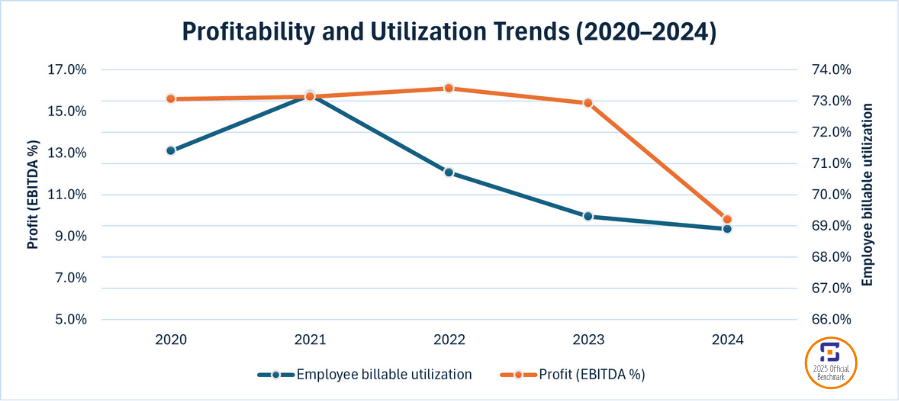For decades, professional services firms have relied on billable utilization as a key performance metric. The equation seemed simple—higher utilization meant greater efficiency, more revenue, and stronger profitability. The 75% utilization benchmark became the industry standard, widely accepted as the optimal balance between billable work and sustainability.
But does it really work?
The latest SPI 2025 PS Maturity™ Benchmark data shows billable utilization rates have fallen to 68.9%, while EBITDA margins have dropped to 9.8%, the lowest in over a decade. This raises a critical question: In a tough climate, where utilization alone is no longer the key to profitability, how do firms achieve sustainable growth?

The 75% Utilization Benchmark: A Foundation, Not a Ceiling
The 75% utilization standard emerged in the late 20th century as firms sought to optimize billable work while allowing time for essential non-billable activities like training, business development, and internal operations. Historically, SPI’s research has shown that utilization between 70-80% maximized profitability—ensuring efficiency without overburdening employees.
However, as firms embrace AI-driven forecasting, globalized delivery models, and evolving client demands, utilization must be viewed within a broader strategic framework. Leading firms are not abandoning utilization—they are refining it to align with profitability, sustainability, and long-term growth.
What Works: Smart Utilization Strategies
Firms that use utilization effectively treat it as a strategic lever, not just a number to maximize. Key strategies include:
✅ Balancing Billable and Non-Billable Time – Top firms ensure consultants dedicate time to training, innovation, and business development to sustain long-term growth. Utilization measurement should enable greater balance, not just track hours.
✅ Role-Specific Utilization Targets – Senior consultants often have lower utilization due to leadership and sales activities, while junior consultants may be expected to exceed 80%. Are you measuring utilization appropriately based on role?
✅ Smarter Resource Allocation – Rather than rigidly scheduling to hit utilization targets, leading firms use data-driven approaches to assign work based on skill demand and business impact. Some leverage AI and predictive analytics, while others have developed alternative mechanisms to match talent effectively. The first step? Understanding your internal skill base and ensuring sales teams align projects with available expertise.
What Doesn’t Work: The Pitfalls of Overemphasizing Utilization
🚫 Chasing Utilization at the Expense of Profitability – Not all billable hours are equal. Filling schedules with low-margin work may boost utilization but erode financial health. Firms must track project margins, client satisfaction, and consultant effectiveness, not just hours worked.
🚫 Ignoring Workforce Sustainability – SPI Research shows that firms exceeding 80% utilization suffer from higher burnout and attrition, leading to long-term declines in performance. In lower-maturity firms, senior consultants are often overburdened due to a lack of delegation, making them increasingly expensive to replace.
Final Thoughts: Utilization in 2025 and Beyond
Utilization remains an essential metric, but firms must recognize it as part of a broader performance strategy, not the sole indicator of success. The most successful organizations balance utilization with strategic resource management, employee well-being, and value-based performance metrics.
So instead of asking, “How do we increase billable utilization?“, is the real question:
“Are we measuring utilization in a way that drives both profitability and workforce sustainability?“
Let us know your thoughts in the comments!
Contact us for information on how we help Professional Services Organizations accelerate service productivity and profitability in today’s current challenges, using SPI’s PS Maturity Assessment™.
About SPI Research:
Since 2006, Service Performance Insight (SPI Research) has been the definitive authority on professional services optimization, benchmarking, and AI-driven transformation. As the creator of the Professional Services Maturity Model™, SPI provides the most comprehensive, data-backed roadmap for firms to enhance productivity, profitability, and sustainable growth.
With insights drawn from over 50,000 service and project-based organizations, SPI’s PS Maturity Assessment™ and benchmarking studies offer actionable guidance to elevate leadership, client relationships, talent strategies, service execution, and financial performance.
Beyond Professional Services Automation (PSA) and ERP optimization, SPI helps firms navigate the evolving landscape of AI, automation, and industry disruption. Our rigorous research and consulting services empower organizations to make informed decisions, outperform competitors, and drive measurable business impact.
For firms looking to scale, lead, and thrive, SPI Research is the trusted partner with the data to prove what works and guide what’s next.
